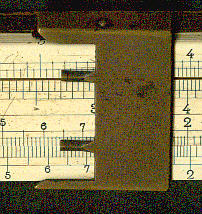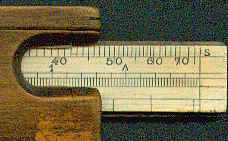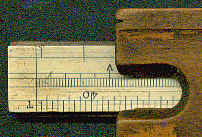1. This is an early French rule. I bought it in a brown paper bag which had: the rule, the A scale, a strip marked with centimetres, the D scale (in 5 segments), the cursor. The loose scales had shrunk, by over 1%, and I did not try to stretch them fearing further damage. The rule has a thin (2mm) centimetre strip on the top edge but a similar strip is missing from the bottom edge. Apart from that it is complete. It is now glued together and the slide and cursor move reasonably freely. For me at least, the rule has almost the same interest as a perfect rule of the same period.
2. An unusual feature of this rule is its all metal cursor which seems to work quite well. This was the type of cursor originally developed around 1850 by Amédée Mannheim, a French artillery officer. Rules with the arrangement of scales on this rule, one cycle logarithmic scales on the lower end of the stock and slide and the two cycle logarithmic (square) scales on the upper end, became known as Mannheim rules.
3. On the back of the slide are sine, tangent and logarithm scales, which also became a common feature of later slide rules. One unusual feature is that the tan scale is inverted relative to the sine scale!. Another feature is that both sine and tangent scales work with the A and B scales. On later rules this remained common for the sine scale but not the tangent scale.
4. The one disadvantage of the arrangement on this rule, not due to the cursor being metal, is that the the cursor becomes loose at the right hand end. A short extension of the rule would have overcome this.
Front view

Manufacturer's name

Detail - cursor



r"(marked as "), 2.06: A
r'(marked as '), 3.44: A